

|
Home Updates Hydros Cars Engines Contacts Links Contact On The Wire |
A Rare 1936 British model engine
|
|
Almost as soon as the internal combustion engine came into being, many companies were set up to take advantage of this new invention and the possible markets that were open to what the French termed 'the explosion motor'. Motorised bicycles, later the motor cycle, cars, boats, aircraft and even models were attracting the attention of companies across Europe. Many of these became household names for the provision of engines as power units to third party manufacturing companies. One of the most successful was Villiers, set up in Wolverhampton in 1898, turning out well in excess of two million units for industrial use, motor cycles, small cars and even aircraft during its life? |
Best known for its two stroke motors that powered thousands of road and competition bikes, the company acquired JAP, an equally well known builder of industrial, aviation, road and racing engines, in 1957. Sadly, Villiers was taken over in the 1960s and the entire group went into liquidation in 1978. What follows are details of one engine that will be unknown to most, but thanks to John Goodall we now have the full story of this venture that unfortunately seems to have been still born despite being ahead of the game in terms of design?
|
John Goodall continues: In the first year I published Model Engine World magazine I was asked if I could identify an interesting model engine by a friend of my son Paul. What turned out to be one of those very many and interesting conversations I had with the late Gordon Counsell who had like myself been a keen motorcyclist and very much a kindred spirit. The conversation later turned into a massive co-incidence in that he said to me "you have heard about the Villiers model engine haven’t you" and I replied 'if I did I cannot recall it'? So Gordon offered to send me a copy of the revue it had been given in the Motorcycle magazine for November 12th 1936 and he added 'maybe you can use it in a future issue of MEW'. Right: Engine on display in the early 1990s |
|
A short while later I obtained the engine and was showing it to a model engineer friend in Barton Under Needwood where I live who also happened to be interested in model engines and two wheelers when it began to dawn on me the engine was almost, but not quite' identical to the engine in the 1936 issue of Motorcycle which Gordon had kindly sent to me. So out came the article and my friend Colin Renshaw agreed with me, it was too similar not to be a Villiers engine and it was therefore very interesting to both of us.
|
Another co-incidence followed a few months later' after I had published an article about the Villiers in MEW issue 5 in September 1994. I had a phone call from a reader up in Liverpool, Mike Broadbent, who said he thought he had a Blue Print drawing for the Villiers engine, would I be interested in a copy? Would I, you bet I would, and Mike kindly sent me a compact disc of the drawing. I had this printed locally and sure enough it proved the engine I had now obtained was indeed a Villiers engine with some slight differences to that shown on the drawing. This concerned the way the needle valve was installed in the cast carburettor intake tube and it could only be fitted the way it was. This proved the engine was intended to be run with the cylinder head below the crank case, or inverted to the normal upright engine shown in the drawing, which presumably was the first made and shown in the 1936 Motorcycle. There was also one less cooling fin and the fins had vertically drilled holes to provide symmetry to the cylinder securing screws and I surmised this was probably done for asthetics. The spark plug might need to run hotter if inverted to avoid fouling, so would these holes have helped, very marginally? Right: Drg #C4731 from 1936 |
|
The bore and stroke of the engine are 0.875" X 1" giving 10cc the same as the drawing. The crank case is also virtually identical apart from as mentioned above and all the internal parts are the same including the roller big end, which is very unusual in a British model engine of this date. The connecting rod was made in steel to house the crowded roller big end making it rather heavy. The crank pin had a large head to retain the rollers and was pressed into the balanced crank disc and proved not to be its best feature, more on this later. The baffled alloy piston carries two compression rings and has a transfer window very similar to Villiers motorcycle engines of the period. The contact breaker assembly is identical to the drawing and these similarities proved to me the engine is indeed a Villiers Model Engine from 1936 and it is very advanced for the that date among its British peers.
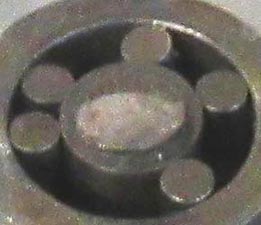 |
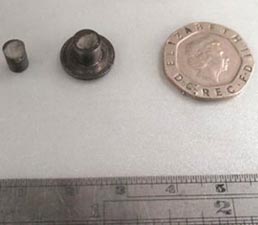 |
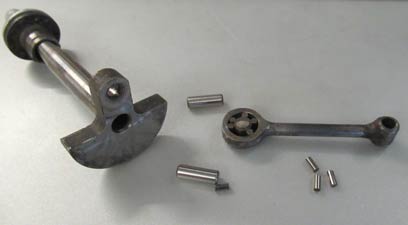 |
| Pin showing long existing crack | Crankpin with roller retaining collar | New crankpin and rollers |
When I dismantled the engine a second time to produce the MEW article almost thirty years ago, the crank pin fell into two pieces and showed a stress fracture where the diameters change with sharp corners which were not radiused, a good engineering practise and it helps distribute the stresses, especially with machined from solid components like this. These features would also be an "achilies heel" when the pin was heat treated to harden it to withstand the roller loads. I have only just managed to get this repaired in 2023 with a new pin and rollers made by a good friend Alan Knight, who did a first class job very quickly.
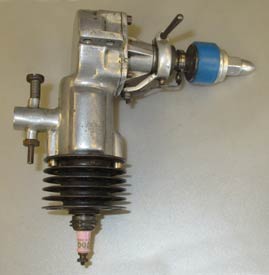 |
 |
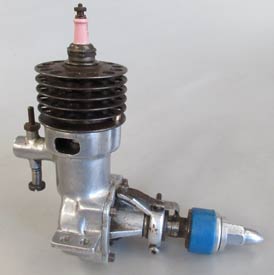 |
| Engine as built for inverted use | Front loading crankcase adopted by many engines of the period | |
From all of this we know at least two engines were made for the two roles envisaged, do readers know of the other missing prototype, if you do please get in touch? The final puzzle is why Villiers did not go ahead into full production? I feel it would have done very well, especially from such a well-known company and with the dearth of model engines generally in Britain at the time.
John Goodall
©copyrightJohnGoodall/OTW2023